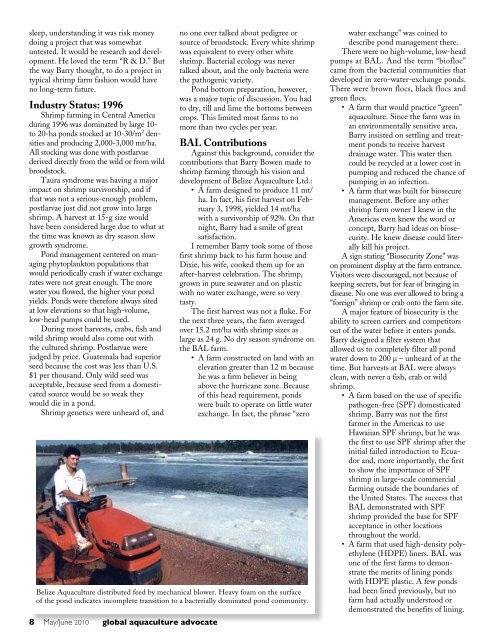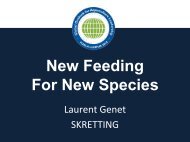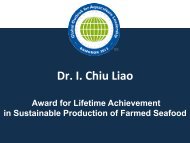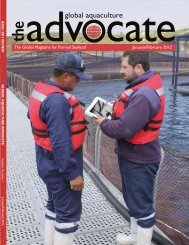May/June 2010 - Global Aquaculture Alliance
May/June 2010 - Global Aquaculture Alliance
May/June 2010 - Global Aquaculture Alliance
Create successful ePaper yourself
Turn your PDF publications into a flip-book with our unique Google optimized e-Paper software.
sleep, understanding it was risk money<br />
doing a project that was somewhat<br />
untested. It would be research and development.<br />
He loved the term “R & D.” But<br />
the way Barry thought, to do a project in<br />
typical shrimp farm fashion would have<br />
no long-term future.<br />
Industry Status: 1996<br />
Shrimp farming in Central America<br />
during 1996 was dominated by large 10-<br />
to 20-ha ponds stocked at 10-30/m 2 densities<br />
and producing 2,000-3,000 mt/ha.<br />
All stocking was done with postlarvae<br />
derived directly from the wild or from wild<br />
broodstock.<br />
Taura syndrome was having a major<br />
impact on shrimp survivorship, and if<br />
that was not a serious-enough problem,<br />
postlarvae just did not grow into large<br />
shrimp. A harvest at 15-g size would<br />
have been considered large due to what at<br />
the time was known as dry season slow<br />
growth syndrome.<br />
Pond management centered on managing<br />
phytoplankton populations that<br />
would periodically crash if water exchange<br />
rates were not great enough. The more<br />
water you flowed, the higher your pond<br />
yields. Ponds were therefore always sited<br />
at low elevations so that high-volume,<br />
low-head pumps could be used.<br />
During most harvests, crabs, fish and<br />
wild shrimp would also come out with<br />
the cultured shrimp. Postlarvae were<br />
judged by price. Guatemala had superior<br />
seed because the cost was less than U.S.<br />
$1 per thousand. Only wild seed was<br />
acceptable, because seed from a domesticated<br />
source would be so weak they<br />
would die in a pond.<br />
Shrimp genetics were unheard of, and<br />
no one ever talked about pedigree or<br />
source of broodstock. Every white shrimp<br />
was equivalent to every other white<br />
shrimp. Bacterial ecology was never<br />
talked about, and the only bacteria were<br />
the pathogenic variety.<br />
Pond bottom preparation, however,<br />
was a major topic of discussion. You had<br />
to dry, till and lime the bottoms between<br />
crops. This limited most farms to no<br />
more than two cycles per year.<br />
BAL Contributions<br />
Against this background, consider the<br />
contributions that Barry Bowen made to<br />
shrimp farming through his vision and<br />
development of Belize <strong>Aquaculture</strong> Ltd.:<br />
• A farm designed to produce 11 mt/<br />
ha. In fact, his first harvest on February<br />
3, 1998, yielded 14 mt/ha<br />
with a survivorship of 92%. On that<br />
night, Barry had a smile of great<br />
satisfaction.<br />
I remember Barry took some of those<br />
first shrimp back to his farm house and<br />
Dixie, his wife, cooked them up for an<br />
after-harvest celebration. The shrimp,<br />
grown in pure seawater and on plastic<br />
with no water exchange, were so very<br />
tasty.<br />
The first harvest was not a fluke. For<br />
the next three years, the farm averaged<br />
over 15.2 mt/ha with shrimp sizes as<br />
large as 24 g. No dry season syndrome on<br />
the BAL farm.<br />
• A farm constructed on land with an<br />
elevation greater than 12 m because<br />
he was a firm believer in being<br />
above the hurricane zone. Because<br />
of this head requirement, ponds<br />
were built to operate on little water<br />
exchange. In fact, the phrase “zero<br />
Belize <strong>Aquaculture</strong> distributed feed by mechanical blower. Heavy foam on the surface<br />
of the pond indicates incomplete transition to a bacterially dominated pond community.<br />
water exchange” was coined to<br />
describe pond management there.<br />
There were no high-volume, low-head<br />
pumps at BAL. And the term “biofloc”<br />
came from the bacterial communities that<br />
developed in zero-water-exchange ponds.<br />
There were brown flocs, black flocs and<br />
green flocs.<br />
• A farm that would practice “green”<br />
aquaculture. Since the farm was in<br />
an environmentally sensitive area,<br />
Barry insisted on settling and treatment<br />
ponds to receive harvest<br />
drainage water. This water then<br />
could be recycled at a lower cost in<br />
pumping and reduced the chance of<br />
pumping in an infection.<br />
• A farm that was built for biosecure<br />
management. Before any other<br />
shrimp farm owner I knew in the<br />
Americas even knew the word or<br />
concept, Barry had ideas on biosecurity.<br />
He knew disease could literally<br />
kill his project.<br />
A sign stating “Biosecurity Zone” was<br />
on prominent display at the farm entrance.<br />
Visitors were discouraged, not because of<br />
keeping secrets, but for fear of bringing in<br />
disease. No one was ever allowed to bring a<br />
“foreign” shrimp or crab onto the farm site.<br />
A major feature of biosecurity is the<br />
ability to screen carriers and competitors<br />
out of the water before it enters ponds.<br />
Barry designed a filter system that<br />
allowed us to completely filter all pond<br />
water down to 200 µ – unheard of at the<br />
time. But harvests at BAL were always<br />
clean, with never a fish, crab or wild<br />
shrimp.<br />
• A farm based on the use of specific<br />
pathogen-free (SPF) domesticated<br />
shrimp. Barry was not the first<br />
farmer in the Americas to use<br />
Hawaiian SPF shrimp, but he was<br />
the first to use SPF shrimp after the<br />
initial failed introduction to Ecuador<br />
and, more importantly, the first<br />
to show the importance of SPF<br />
shrimp in large-scale commercial<br />
farming outside the boundaries of<br />
the United States. The success that<br />
BAL demonstrated with SPF<br />
shrimp provided the base for SPF<br />
acceptance in other locations<br />
throughout the world.<br />
• A farm that used high-density polyethylene<br />
(HDPE) liners. BAL was<br />
one of the first farms to demonstrate<br />
the merits of lining ponds<br />
with HDPE plastic. A few ponds<br />
had been lined previously, but no<br />
farm had actually understood or<br />
demonstrated the benefits of lining.<br />
Barry Bowen was a proud Belizean who actively participated in his “hard asset”<br />
investments.<br />
BAL clearly showed that HDPE<br />
allowed quick pond turnaround times,<br />
increasing the number of harvest cycles<br />
per year. HDPE also protected the freshwater<br />
aquifers from saltwater intrusion.<br />
Monitor wells proved this out. But more<br />
than one expert told Barry that he could<br />
not grow shrimp on plastic.<br />
• A farm that mechanized as much as<br />
possible. Both feeding and harvesting<br />
activities were mechanized to<br />
reduce the amount of labor<br />
required. Production of 900 mt of<br />
shrimp was accomplished with<br />
three individuals. Typically, farms<br />
would employ many pond feeders<br />
to manually apply feed and clean<br />
screens. This was not the case at<br />
BAL.<br />
• A modular hatchery and maturation<br />
system that operated continuously<br />
for the five years I was present. It<br />
never required the scripted dryouts<br />
that were part of so many hatchery<br />
protocols. By building a modularized<br />
hatchery, the operation could<br />
be operated efficiently 12 months<br />
per year.<br />
The project was not without problems.<br />
But every time a problem developed,<br />
Barry Bowen was steady and<br />
focused. Barry did not allocate blame, it<br />
was R & D. And so we learned and continued<br />
to refine the concept of BAL. The<br />
results spoke for themselves, and further<br />
improvements were made in stocking,<br />
water management and operation of the<br />
settling basins and recycling systems.<br />
Practical Environmentalist<br />
On occasion, Barry Bowen was<br />
attacked for his “environmentalism.”<br />
Barry was a practical environmentalist.<br />
He funded naturalists at his Gallon Jug<br />
Estate and personally loved to hike<br />
though the jungle and watch birds and<br />
other wildlife. He donated 110,000 ha of<br />
jungle land, which became the Rio Bravo<br />
Conservation and Management Area,<br />
ensuring a natural heritage for future<br />
generations of Belizeans.<br />
Barry was consistent in his belief that<br />
shrimp farming could be and should be<br />
done with the environment in mind. And<br />
he made Belize <strong>Aquaculture</strong> a testament<br />
to that belief. But as he told me once: “I<br />
lose patience with those people who<br />
think environmentalism is not to develop<br />
an economy. Developed economies are<br />
required for people to lead better and<br />
happier lives. I bet each of the environmentalists<br />
from the so-called developed<br />
world lives with a yard full of grass that<br />
used to have a virgin forest on it. Their<br />
ancestors did what we in Belize must now<br />
do to develop, and for that we are criticized.”<br />
Father Of Modern Shrimp<br />
Farming<br />
Let me conclude by saying that in my<br />
mind, shrimp farming was changed by<br />
Barry Bowen, changed for the better. He<br />
is my “father of modern shrimp farming.”<br />
He changed ideas that resulted in a more<br />
sustainable model that produces shrimp<br />
with predictability, in quantities never<br />
thought possible and at lower costs that<br />
continually make shrimp more available<br />
to more and more consumers.<br />
Today, shrimp farmers and those<br />
involved in researching shrimp culture<br />
technology routinely talk about biofloc,<br />
limited water exchange, the pedigrees of<br />
shrimp, biosecurity, pushing production<br />
envelopes, developing new markets based<br />
on freshness and green technologies.<br />
Barry Bowen dreamed of these ideas<br />
before any of us, and he had the boldness<br />
to act on his dreams and the skill to make<br />
them happen.<br />
Thank You<br />
I was privileged to work for Barry<br />
Bowen, and for that privilege, I have<br />
become a better shrimp culturist, a culturist<br />
who is no longer bound by limits<br />
set by industrial thinking. Thank you, Sir<br />
Barry Bowen.<br />
A legend is someone about whom<br />
everyone you meet has a story to tell, and<br />
generally a story larger than life itself.<br />
This was Barry Bowen. Anyone in Belize,<br />
on the mention of the name Barry<br />
Bowen, had a story to tell.<br />
Barry, you were a living legend in<br />
Belize. And Belize will never see another<br />
like you.<br />
Sir Barry Bowen<br />
Barry Bowen was knighted by<br />
Queen Elizabeth in 2008 for his<br />
many contributions to Belize.<br />
Thereafter he became Sir Barry<br />
Bowen.<br />
Sir Barry Bowen was given an<br />
official state funeral that attracted<br />
thousands of people to pay<br />
respects as the official motorcade<br />
traveled from the funeral service to<br />
his internment in Cayo.<br />
Prime Minister Dean Barrow<br />
said the following about Barry<br />
Bowen during the interment:<br />
“He was obviously one of the<br />
greatest modern-day Belizeans,<br />
one of the greatest Belizeans of his<br />
generation. It’s not just that he<br />
was so immensely successful as a<br />
businessman, it was the fact that<br />
he was always prepared to take<br />
risks, that he was always prepared<br />
to diversify, even when it meant<br />
that he would get into new areas<br />
that were far from certain in terms<br />
of offering the kinds of returns<br />
that businessmen and entrepreneurs<br />
would normally look for.<br />
That is what I found most outstanding<br />
about him – that he had<br />
a mindset that suggested that he<br />
could get anything out of the<br />
Belizean earth.”<br />
8 <strong>May</strong>/<strong>June</strong> <strong>2010</strong> global aquaculture advocate<br />
global aquaculture advocate <strong>May</strong>/<strong>June</strong> <strong>2010</strong> 9





